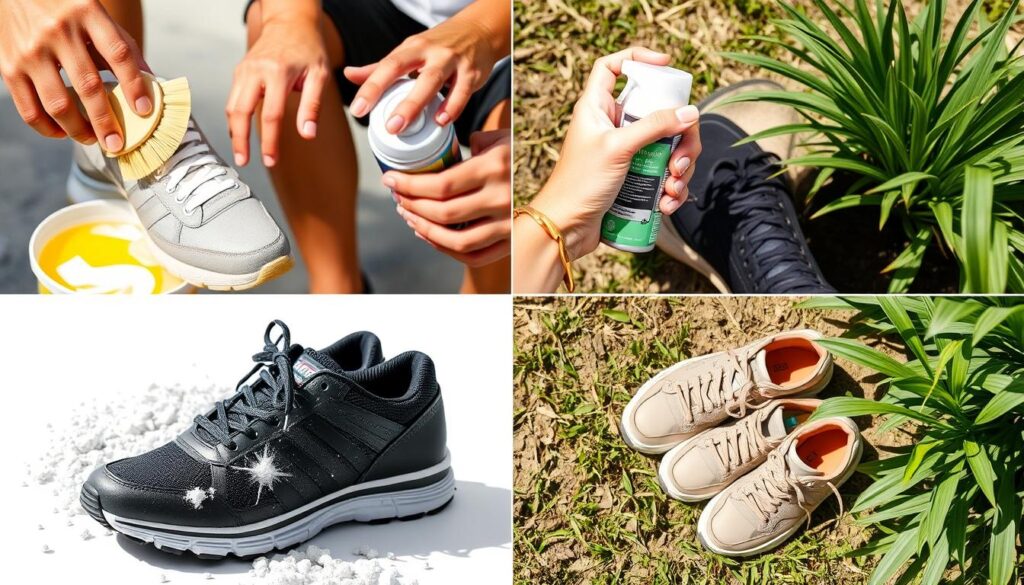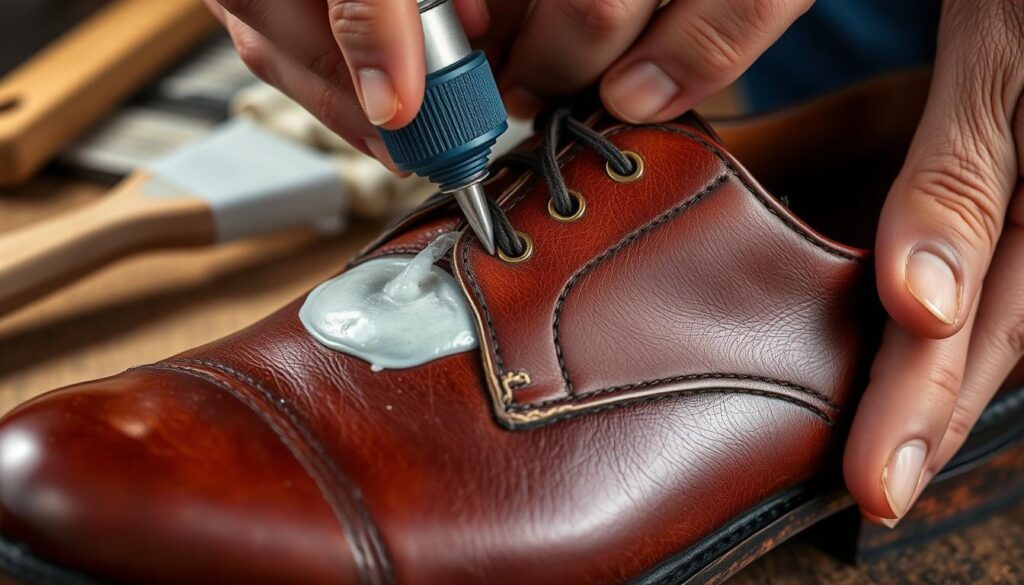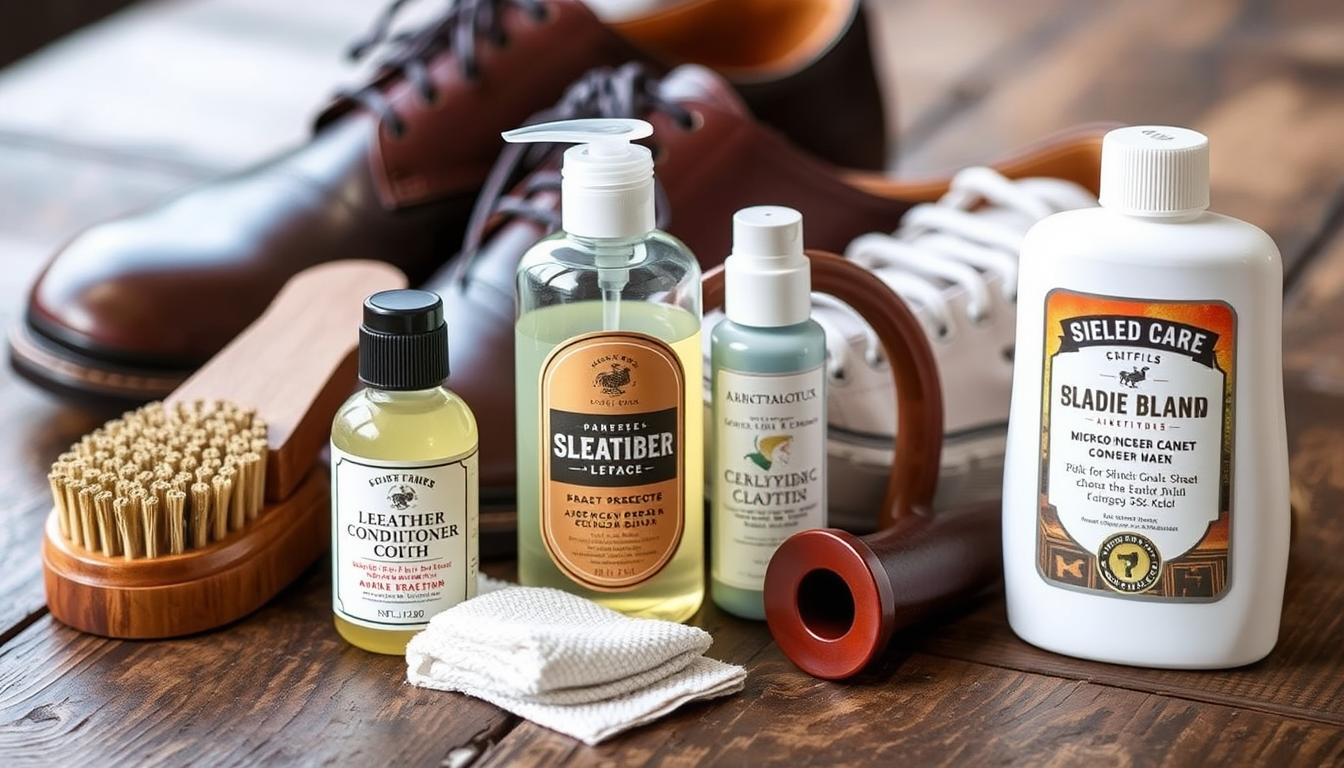Top shoe care tips to keep your footwear looking new. In a world where fashion statements are made with every step, the condition of your shoes can make or break your style. But did you know that proper shoe care is not just about appearances? Maintaining your footwear can extend its lifespan, saving you money in the long run. So, what’s the secret to keeping your shoes looking fresh and new for longer?
Discover the top shoe care tips that will have your footwear poised to impress, no matter the occasion. From daily cleaning routines to specialized treatment for delicate materials, this comprehensive guide will equip you with the knowledge and tools to ensure your shoes remain in tip-top shape. Get ready to step out in confidence, knowing your footwear is meticulously cared for.
Key Takeaways
- Understand the importance of regular shoe maintenance for extended lifespan and appearance
- Learn effective daily cleaning and protection techniques for all types of shoes
- Discover specialized care methods for leather, suede, and athletic footwear
- Explore the benefits of using shoe protectors and proper storage solutions
- Tackle common issues like odors, water damage, and wear-and-tear with expert advice
Top Shoe Care Tips to Keep Your Footwear Looking New. Understanding the Importance of Shoe Care
Maintaining the longevity and appearance of your footwear is crucial, yet often overlooked. Regular shoe care not only extends the lifespan of your shoes but also helps maintain the shine and luster on dress shoes, ensuring you always look your best. In this section, we’ll explore why shoe care matters and the benefits of establishing a consistent maintenance routine.
Why Shoe Care Matters
Your shoes are an investment, and proper care can significantly prolong their life. Neglecting footwear can lead to premature wear and tear, resulting in unsightly creases, scuffs, and discoloration. By dedicating a few minutes each day to cleaning, conditioning, and protecting your shoes, you can ensure they maintain their pristine condition for years to come.
The Cost of Neglecting Footwear
Failing to care for your shoes can be a costly mistake. Replacing worn-out or damaged footwear can quickly add up, especially for high-quality dress or designer shoes. Regular maintenance, on the other hand, can save you money in the long run by preventing the need for frequent replacements.
Benefits of Regular Maintenance
- Extends the lifespan of your shoes
- Preserves the original shine and luster
- Protects against scuffs, scratches, and water damage
- Maintains the overall appearance and professional look
- Saves money by reducing the need for premature replacements
By investing a little time and effort into caring for your shoes, you can ensure they look their best and remain a reliable part of your wardrobe for years to come. The next section will dive into the daily maintenance tips for all types of footwear.
Daily Maintenance Tips for All Types of Shoes
Proper shoe care is essential for maintaining the longevity and appearance of your footwear. Whether you own leather, suede, or athletic shoes, incorporating daily maintenance habits can keep your shoes looking their best. In this section, we’ll explore practical tips for cleaning, inspecting, and protecting your shoes against common issues like scuffs and scratches.
Cleaning Your Shoes Daily
Begin your daily shoe care routine by giving your footwear a quick clean. Use a soft-bristled brush or a clean, damp cloth to remove any surface dirt or debris. For leather shoes, gently wipe them down with a leather cleaner or a mixture of water and mild soap. Suede and nubuck shoes require a specialized suede brush to lift and remove dirt without damaging the delicate material.
Inspecting for Damage
- Take a few moments each day to examine your shoes for any signs of wear, such as cracking, scuffs, or loose threads.
- Pay close attention to high-friction areas like the toes and heels, as these are the first to show signs of damage.
- Address any issues you find promptly to prevent further deterioration and extend the life of your shoes.
Protecting Against Scuffs and Scratches
Scuffs and scratches can be a common problem, especially for leather shoes. To prevent these unsightly blemishes, consider applying a shoe protector or conditioner. These products create a barrier that shields the material from everyday wear and tear. Be sure to follow the manufacturer’s instructions carefully when applying these products to ensure optimal protection.
By incorporating these daily maintenance tips into your routine, you can keep your shoes looking their best and extend their lifespan. Remember, investing a few minutes each day in proper shoe care can save you time and money in the long run.
How to Clean Different Shoe Materials
Maintaining the pristine condition of your footwear requires tailored care techniques for various materials. From leather to suede and athletic shoes, each type of shoe demands a unique approach to ensure it stays looking its best. Let’s dive into the best practices for cleaning and conditioning different shoe materials.
Leather Shoes: Cleaning and Conditioning
Leather is a classic and durable material, but it requires regular attention to keep it looking its best. Start by gently wiping down your leather shoes with a damp cloth to remove surface dirt and debris. Then, apply a high-quality leather conditioner to nourish and protect the material. Massage the conditioner into the leather, paying special attention to any creased or worn areas. Allow the conditioner to soak in, then buff the shoes with a soft cloth for a smooth, glossy finish.
Suede and Nubuck: Special Care Techniques
Suede and nubuck require more delicate handling to maintain their distinctive textures. Use a suede brush or specialized suede cleaner to gently lift dirt and stains from the surface. Avoid using water, as it can cause discoloration. For deeper cleaning, consider taking your suede or nubuck shoes to a professional. They have the tools and expertise to revive the material without damaging it.
Athletic Shoes: Best Practices for Cleaning
Keeping your athletic shoes in top shape is essential for both performance and appearance. Start by removing the laces and insoles, then use a soft-bristle brush and mild detergent to scrub the uppers, soles, and midsoles. Rinse the shoes thoroughly and stuff them with paper towels to help them retain their shape as they dry. For best results, avoid putting your athletic shoes in the washing machine, as this can compromise their structural integrity.
By following these leather conditioning, suede protection, and shoe cleaning techniques, you can keep your footwear looking and feeling like new for longer. Remember, regular maintenance is key to preserving the longevity and visual appeal of your shoes.
The Role of Shoe Protectors
Preserving the longevity and pristine appearance of your footwear is a top priority for many shoe enthusiasts. One effective way to achieve this is by utilizing shoe protectors. These specialized products play a crucial role in safeguarding your investment, whether you own a pair of luxurious leather loafers or a beloved set of suede boots.
Types of Shoe Protectors Available
When it comes to shoe protection, there is a diverse range of options to choose from. Waterproofing sprays and creams are popular choices for waterproofing shoes, creating an invisible barrier that shields against moisture and stains. For suede protection, suede protectors and brushes help maintain the soft, velvety texture and prevent discoloration.
- Waterproofing sprays and creams
- Suede protectors and brushes
- Leather conditioners and polishes
- Shoe trees and inserts
When to Use a Protector
Shoe protectors are recommended for various situations, from daily wear to special occasions. Applying a protector before a rainy commute or a day spent outdoors can help prevent water damage and stains. Similarly, using a suede protector on your favorite pair of ankle boots can preserve their luxurious appearance for years to come.
How to Apply Shoe Protectors Properly
Proper application is key to ensuring the effectiveness of shoe protectors. Always follow the manufacturer’s instructions, and be sure to thoroughly clean and dry the shoes before applying the product. Evenly distribute the protector across the entire surface, taking care to cover all high-wear areas. Allow the recommended drying time before wearing the shoes to ensure maximum protection.
https://www.youtube.com/watch?v=fflkvx1tERA&pp=ygUPI2NoYW5lbHNsaXBwZXJz
By incorporating shoe protectors into your regular footwear maintenance routine, you can safeguard your investment and keep your shoes looking their best for seasons to come.
Proper Storing Techniques for Shoes
Maintaining the longevity of your footwear isn’t just about regular cleaning and care – proper storage techniques also play a crucial role in extending shoe lifespan. From finding the ideal storage solutions to preventing overcrowding, let’s explore the essential practices for preserving the condition of your shoes.
Ideal Shoe Storage Solutions
The key to well-organized and proper shoe storage is to provide each pair with its own dedicated space. Invest in shoe racks, shelves, or clear plastic boxes to keep your collection neat and easily accessible. Avoid tossing shoes haphazardly into closets or under beds, as this can lead to unwanted creases and deformities.
The Importance of Keeping Shoes Dry
Moisture is the enemy of footwear. Ensure that your shoes are completely dry before storing them, as excess humidity can promote the growth of mold and mildew, leading to unpleasant odors and irreversible damage. Consider using silica gel packets or dehumidifiers to control the moisture levels in your storage area.
Avoiding Overcrowding
- Resist the temptation to cram too many shoes into a single space.
- Overcrowding can cause shoes to lose their shape and cause premature wear and tear.
- Allocate enough room for each pair to maintain its structure and prevent creasing.
By following these proper shoe storage techniques, you can effectively extend the lifespan of your footwear and keep your collection looking its best for years to come.
Tips for Removing Odors from Shoes
Keeping your shoes fresh and odor-free is essential for both personal comfort and hygiene. Whether you’re dealing with the lingering scent of sweaty feet or the musty smell of old shoes, there are several effective strategies to eliminate unpleasant odors. Let’s explore some natural remedies, commercial products, and the importance of replacing insoles.
Natural Remedies for Shoe Odor
For a more eco-friendly and cost-effective approach, try these natural solutions to combat shoe odors:
- Baking soda: Sprinkle a small amount of baking soda inside your shoes and let it sit overnight to absorb moisture and neutralize odors.
- Charcoal bags: Activated charcoal bags can be placed in your shoes to effectively absorb odors and keep your footwear fresh.
- Essential oils: Add a few drops of tea tree, lavender, or peppermint oil to a cotton ball and place it inside your shoes to naturally deodorize them.
Commercial Products That Work
If you prefer a more heavy-duty solution, various commercial products are designed to eliminate shoe odors. Some effective options include:
- Shoe deodorizing sprays: These sprays contain antimicrobial ingredients that kill the bacteria responsible for foot odor.
- Odor-eliminating insoles: Specialized insoles with built-in odor-fighting technology can be a game-changer for smelly shoes.
- Shoe fresheners: Hanging sachets or placing small packets in your shoes can continuously freshen the air and prevent odors.
When to Replace Your Insoles
Over time, the insoles in your shoes can become a breeding ground for bacteria and cause unpleasant odors. As a general rule, it’s recommended to replace your insoles every 6 to 12 months, or whenever you notice a significant buildup of odor or wear and tear. This simple step can help extend the lifespan of your shoes and keep them smelling fresh.

By implementing these shoe cleaning techniques and being proactive about extending shoe lifespan, you can maintain the freshness and longevity of your footwear, ensuring a comfortable and confident stride every step of the way.
How to Deal with Water Damage
Accidents happen, and sometimes our beloved shoes fall victim to water damage. Whether it’s a sudden downpour or a spill, dealing with waterlogged footwear can be a frustrating experience. But fear not, there are effective ways to salvage your shoes and prevent future water-related issues.
Immediate Steps to Take
When your shoes get wet, the first step is to address the issue right away. Blot the excess water with a clean, dry cloth or paper towels. Avoid rubbing or wringing the shoes, as this can further damage the material. If the shoes are leather or suede, stuff them with newspaper or clean, absorbent rags to help them retain their shape as they dry.
Treating Water Stains on Different Materials
- Leather: Create a solution of warm water and mild soap, and gently clean the affected areas with a soft-bristled brush. Condition the leather afterward to restore its suppleness and sheen.
- Suede and Nubuck: Use a suede brush or eraser to gently remove any water stains. Avoid using water, as it can further discolor the material.
- Canvas and Fabric: Blot the area with a clean cloth, then use a mild detergent and warm water to spot-clean the stain. Allow the shoes to air dry completely.
Preventing Future Water Damage
To protect your shoes from future water-related issues, consider investing in a waterproofing spray or treatment. These products create a protective barrier that helps repel water and prevent stains. Apply the waterproofing agent according to the manufacturer’s instructions, and reapply it periodically to maintain the effectiveness.
By following these tips, you can successfully waterproof your shoes and remove stains from shoes caused by water exposure. With a little care and attention, your footwear can maintain its like-new appearance for longer.
Repairs and Restoration of Worn Shoes
As our favorite shoes start to show signs of wear and tear, it’s important to know when to seek professional help or tackle repairs ourselves. Recognizing the right time to address scuffs, scratches, and other damage can extend the lifespan of our footwear and keep our shoes looking fresh for longer.
Recognizing Damage That Needs Repair
The first step in shoe repair and restoration is to inspect your footwear regularly. Look for issues like worn soles, cracked leather, loose stitching, or damaged eyelets. These problems won’t fix themselves and may worsen over time, so it’s best to address them before they become more serious.
Professional vs. DIY Repairs
For more complex issues, such as repairing scuffs and scratches or resoling shoes, it’s often best to seek the help of a professional cobbler. They have the expertise and specialized tools to restore your shoes to their former glory. However, there are also many DIY repairs you can tackle at home, like applying leather conditioner or replacing laces, to help extend the lifespan of your footwear.
When It’s Time to Replace Your Footwear
Despite our best efforts, there comes a time when even the most beloved pair of shoes needs to be retired. Signs it’s time to let go include significant structural damage, worn-out cushioning, or the inability to properly repair the shoes. By recognizing when it’s time to replace your footwear, you can ensure your feet stay comfortable and protected.

Caring for your shoes doesn’t have to be a daunting task. By understanding when to seek professional help, tackling DIY repairs, and knowing when it’s time to start fresh, you can keep your footwear looking and feeling its best for years to come.
Seasonal Shoe Care Essentials
As the seasons change, so do the demands on our footwear. Maintaining the condition of your shoes throughout the year requires a tailored approach to ensure they remain in top shape. Let’s explore the essential shoe care tips for the different seasons.
Summer Shoe Care Tips
During the hot summer months, our shoes are exposed to sweat, sand, and increased wear and tear. To keep your footwear looking and feeling fresh, regularly clean them with a mild soap and water solution. Waterproofing your shoes can also help protect them from the elements. Additionally, allow your shoes to air dry completely before wearing them again to prevent the buildup of moisture and odor.
Winter Feet: Protecting Shoes from Snow
The harsh winter weather can wreak havoc on your shoes. To shield them from the snow, salt, and slush, invest in a high-quality waterproofing spray or cream. This will help repel moisture and prevent premature wear and tear. When returning indoors, be sure to wipe down your shoes with a damp cloth to remove any residual salt or dirt.
Spring Cleaning for Your Footwear
As the flowers bloom and the weather warms, it’s the perfect time to give your shoes a thorough cleaning. Start by removing any accumulated dirt and debris with a soft-bristled brush or cloth. Then, use specialized shoe cleaning techniques, such as leather conditioning or suede brushing, to restore the luster and vibrancy of your footwear. Don’t forget to replace worn insoles for a fresh, comfortable feel.
By tailoring your shoe care routine to the changing seasons, you can ensure that your footwear remains in pristine condition all year round. With a little effort and the right techniques, you can extend the life of your shoes and keep them looking their best, whether you’re navigating summer heat or winter’s chill.
Choosing the Right Shoe Care Products
Maintaining the pristine condition of your favorite footwear requires more than just a quick wipe-down. To keep your leather, suede, and dress shoes looking their best, it’s essential to invest in the right shoe care products. From essential cleaning supplies to eco-friendly options, this guide will help you navigate the world of shoe care with confidence.
Must-Have Cleaning Supplies
- Soft-bristled shoe brush: This versatile tool is essential for gently removing dirt and debris from a variety of shoe materials.
- Leather conditioner: Regularly conditioning your leather shoes will help preserve their supple texture and luster.
- Suede brush: Specially designed to revive the nap on suede and nubuck, this brush is a must-have for maintaining the unique finish of these materials.
- Water-based protector: Applying a water-based protector to your shoes can help shield them from scuffs, stains, and moisture.
Recommended Brands for Each Material
When it comes to shoe care, not all products are created equal. For the best results, look for well-regarded brands that specialize in the material of your footwear:
| Shoe Material | Recommended Brands |
|---|---|
| Leather | Bickmore, Saphir, Kiwi |
| Suede | Tarrago, Jason Markk, Collonil |
| Dress Shoes | Allen Edmonds, Meltonian, Lincoln |
Eco-Friendly Options
For the environmentally conscious consumer, there are plenty of eco-friendly shoe care products available that deliver effective results without harming the planet. Look for formulas that are free of harsh chemicals and made with natural, biodegradable ingredients, such as those from brands like Callaghan and Angelus.
By investing in the right shoe care products, you can extend the life of your favorite footwear and maintain their leather conditioning, suede protection, and shine on dress shoes for years to come.
Final Thoughts on Shoe Care
Establishing a consistent shoe care routine is the key to keeping your footwear looking its best for years to come. By investing a little time and effort into regular maintenance, you can extend the lifespan of your shoes and ensure they continue to provide comfort and style. From daily cleaning to seasonal protection, each step plays a vital role in preserving the integrity of your favorite pairs.
The Joy of Well-Cared-For Footwear
There’s a genuine sense of satisfaction that comes from seeing your well-cared-for shoes in pristine condition. Whether it’s a pair of leather oxfords or your go-to athletic sneakers, taking pride in the appearance of your footwear can boost your overall confidence and make every step more enjoyable.
Investing in Your Footwear’s Longevity
While it may seem like an extra chore, a consistent shoe care routine is an investment that pays dividends in the long run. By protecting your shoes from wear and tear, you can avoid the need for costly repairs or premature replacement, ultimately saving you money and ensuring your footwear remains a trusted companion for years to come.





